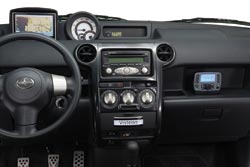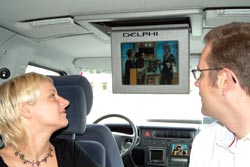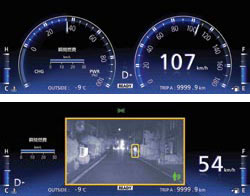Today’s dashboard looks like the cockpit of a fighter jet, with a whole lot of consumer electronic gadgetry thrown in.
The old adage “Keep your eyes on the road” has taken on new meaning, thanks to sophisticated in-car displays. Today’s instrument clusters tell you how fast you’re going, how much gas you have left, and whether your car is about to overheat or your right blinker is still on. But the traditional gauges have morphed into “infotainment” devices. Besides looking at the road, you can search Web sites, watch movies, check e-mail, look at maps and more. This might sound like staying on the road could be a challenge to today’s driver, but, fortunately, improved automotive design takes human cognitive ability into consideration while making the most of the latest in display and lighting technologies.
Human meets machine
User-centered design has caught on in the automotive industry as quickly as has in-car infotainment. The two go hand in hand. As automakers add GPS navigation, TV, video, Internet, satellite radio and so on, it’s imperative that they study human-machine interaction (HMI).
Tim Yerdon, director of global innovation, design and advanced electronics at Visteon Corp. of Van Buren Township, Mich., explained that designing products that can successfully integrate attractive new features while limiting the incremental information processing burden imposed on the driver is a critical objective of his company’s advanced development work in HMI.
Visteon uses the term “cockpit electronics” to refer to audio and infotainment, driver information and center stack electronics. These systems can be as sophisticated as designers want to make them, but it’s important to have the right amount of information showing up at the right time, Yerdon noted.

Cockpit electronics, as shown here in a Scion xB, includes infotainment devices such as a high-definition radio receiver and a navigation system. Photo courtesy of Visteon Corp.
Delphi Corp. of Auburn Hills, Mich., also relies on HMI for technologies that will allow safe driving while providing the electronic gadgetry that consumers demand. One example is the dual-view navigation/video system. The driver can see the map, but if he tries to watch the video, sensors will disable the unit.

A pop-down television display uses multiple in-glass or composite body structure antennas, integrated amplifiers and scanning diversity technology. Photo courtesy of Delphi Corp.
Other techniques for keeping drivers’ eyes on the road are more visible displays. This requires LCD gauges utilizing the latest display technologies and smart use of lighting and sophisticated sensing.
The in-car display
Automotive displays once offered two choices: pixel on or pixel off, and in only one color, according to Silviu Pala, director of engineering at Southfield, Mich.-based Denso International America. Now we have powerful color graphic processors that have come out of the gaming industry. Denso makes sensors, instrument clusters and image-recognition systems for the auto industry. Today’s display technology of choice is the LCD-based thin-film transistor (TFT), which Pala considers an “enabler” in comparison with low-resolution monocolor displays. The goal, he said, is to have an analog image on a digital display.

A thin-film-transistor instrument cluster from Denso North America is shown in normal mode (top) and with a night-vision view (bottom). Photos courtesy of Denso North America.
Much value is placed on personalization and appearance in automotive interiors, and TFT enables designers to use a variety of colors on a reconfigurable full-size (12.3 in.) display. As a result, they can be switched according to the driver’s preference from sports mode to economy or night-view image mode. This new technology is in the instrument cluster of the 2008 Toyota Crown Hybrid, available in Japan.
LED lighting
The auto industry has moved away from fluorescent lighting for TFT LCDs, largely because of restrictions on using parts that contain mercury. The replacement, LED backlighting, is not without its challenges.
Brian Dehmlow is a display technology supervisor at Yazaki North America, a company that makes head-up displays, digital clusters and other vehicle information systems. He sees three variables with LCDs: “how bright, how to get the heat out and how to do it in the most compact package.”
Ray Lippmann, a staff research engineer at Delphi, adds that LCD lighting is “hideously inefficient” and would benefit from some additional research and development. For a 400-nit display, for example, you need a 20× light source, Lippmann pointed out. “At dollars per lumen, that’s a lot of wasted expense.”
More designs employ TFT displays backlit with LEDs. According to Lippmann, the trick, so far, in lighting systems has been to lower costs by using LED light much more efficiently. One big change in LEDs is that designers can tune their own colors. Custom colors are available, but “they are a real pain,” Lippmann said. Using an unusual approach, Delphi efficiently captures light at the LED and controls the flux while transporting it to the target area.
Not long ago, organic LEDs were touted as the automotive light source of the future. Lippmann describes OLEDs as “a really good potential technology for automotives.” But for all their advantages, they have failed to find a home in automotive applications. They use energy efficiently but degrade on the basis of how much light they put out and on operating temperature and time. Seals have been an issue also because water intrusion is the enemy of the OLED.
To Lippmann, the big question is whether OLEDs can hold up to the 10,000-h average lifespan of an automobile and whether they can garner enough investment to move further down the cost curve.
The next step in lighting may be UV LEDs, which “allow you to play tricks with light to lower system costs,” Lippmann said.
Sophisticated sensing
A range of sensors assists with visibility of automotive displays as well as with control of knobs and switches on the instrument panel. Ambient light sensors can match how the iris in the human eye responds to light, adjusting the overall brightness of a display based on how much light is coming into the car. Dimming the display also extends battery life – something that is becoming more important with the influx of hybrid and/or electric vehicles.
Today’s light sensors include additional integrated circuits and offer analog-to-digital conversion for easy integration of the sensor into existing automotive controllers.
Sensitivity also is improved, according to Sevugan Nagappan, product marketing manager for Osram Opto Semiconductors Inc. of Santa Clara, Calif.
Light sensors now can go from 1 to 80,000 lx, or the equivalent of bright daylight. And the next step is proximity sensing. An automotive display will appear dark until the driver’s hand gets close to a switch. The sensor will optically detect the presence of an object/hand and light up the display. Nagappan said we will begin seeing this in cars in 2012, first with higher-end vehicles and then cascading down to other models.
Coming down the pike
Today it’s infotainment; tomorrow it’s driver comfort and safety. Delphi is working on what it calls the ICP (Information, Convenience, Protection) system, which will use seven cameras – five aimed on the occupants of the car, one aimed on the road in front and another behind. The system also uses facial recognition to change temperature and seat position, and to lock the ignition if it doesn’t recognize the driver. Night vision is already here, but we are starting to see pedestrian detection, which someday may evolve into a daytime application.

The second-generation night-vision system alerts drivers to a pedestrian in the road. Photo courtesy of Autoliv.
Also under development are micro-projectors for use in head-up displays. Designers are working on multitiered surfaces to enable different views, but until price comes down and robustness increases, automotive projectors will continue to be under development.
And the green trend has not failed to find a place in automotive displays. Hypermilers – people who try to eke out every mile per gallon possible – may find a green vine on the instrument panel of the new Ford hybrid and electric vehicles. When you take your foot off the gas, the vine grows. Floor it, and the vine shrinks, indicating your level of energy savings.